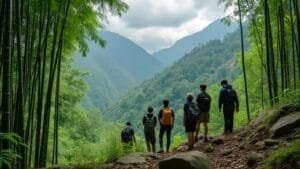Red pandas, an iconic species native to the Eastern Himalayas and southwestern China, face mounting threats due to habitat fragmentation, poaching, and climate change. In response, several international organizations have launched coordinated conservation efforts to protect this endangered species. What are the key international conservation programs focused on red pandas? From genetic preservation projects to community-based conservation and captive breeding strategies, the global response integrates both in-situ and ex-situ solutions
This article explores the leading programs that combine scientific research, local empowerment, and global cooperation to safeguard red pandas. We’ll dive into efforts by the Red Panda Network, World Wildlife Fund, IUCN, and others, illustrating how their strategies—from forest patrols to frozen zoos—are helping mitigate human-made threats and promote habitat connectivity across Asia’s mountainous landscapes
Major International Efforts to Conserve Red Pandas

Red pandas are not just one of the world’s most charismatic species—they are also one of the most vulnerable. Their range spans across five countries: Nepal, Bhutan, India, Myanmar, and China. Due to their sensitivity to environmental change and habitat fragmentation, their conservation requires a coordinated international effort
Various programs worldwide are now focused on both protecting wild populations in their natural habitats (in-situ conservation) and maintaining genetically viable populations through breeding and research (ex-situ conservation)
The Red Panda Network’s Model for Community-Led Conservation
Founded in 2007, the Red Panda Network (RPN) has become one of the most impactful grassroots organizations focused exclusively on red panda conservation. Working primarily in Nepal’s eastern Himalayas, RPN integrates community development with environmental protection, demonstrating how local stewardship can drive biodiversity preservation
One of its most successful initiatives is the Forest Guardians Program, which trains local villagers to monitor red panda populations, patrol forests for signs of poaching, and conduct habitat surveys. These guardians are not only protectors but also educators, spreading conservation awareness in their communities. According to RPN, their guardians patrol over 100 km² of red panda habitat annually, reporting threats and maintaining habitat integrity
Additionally, RPN has pioneered habitat restoration through its “Plant A Red Panda Home” campaign. By collaborating with community forest user groups, the organization facilitates reforestation in fragmented corridors to enhance habitat connectivity. This restoration strategy supports population dispersal and genetic flow—both essential for long-term species resilience
RPN also integrates community-based ecotourism, helping locals develop sustainable businesses that benefit from, rather than harm, red panda habitats. This incentive-based conservation model reduces the community’s dependency on forest exploitation and provides alternative livelihoods
To explore more about this integrated conservation strategy and how it empowers local communities to protect red pandas, visit the Red Panda Network homepage, which outlines ongoing projects and impact metrics in Nepal
Global Captive Breeding Programs and Genetic Preservation
Captive breeding has become a core element of global red panda conservation, ensuring a genetically viable population for future reintroduction and educational purposes. Leading this initiative is the Red Panda Global Species Management Plan (GSMP), coordinated by the World Association of Zoos and Aquariums (WAZA). The GSMP synchronizes the efforts of zoos and conservation centers across continents, focusing on genetic diversity, health monitoring, and standardized care
One of the primary tools supporting GSMP is the International Studbook, managed by Rotterdam Zoo. It meticulously records the genetic lineage of every red panda in captivity worldwide, facilitating coordinated breeding that avoids inbreeding and preserves critical genetic traits. Complementing this, the Species Survival Plan (SSP) in North America and the European Endangered Species Programme (EEP) work to manage breeding populations within accredited zoos
These programs are bolstered by recent innovations such as India’s “Frozen Zoo” initiative at the Padmaja Naidu Himalayan Zoological Park in Darjeeling. This facility stores genetic material (sperm, eggs, tissue samples) from wild and captive red pandas, enabling future research and assisted reproduction techniques like in-vitro fertilization. Such approaches are especially important for maintaining genetic resilience in case of catastrophic loss in the wild
By integrating ex-situ conservation with in-situ habitat protection, these breeding programs serve not just as insurance policies, but also as active contributors to long-term species recovery. They reflect a growing understanding that real conservation success lies in coordination between zoological institutions, genetic scientists, and field researchers
To understand more about these international efforts, you can review the Red Panda GSMP page by WAZA, which details breeding goals and the global collaboration behind them
The IUCN Red List’s Role in Conservation Strategy Development
The International Union for Conservation of Nature (IUCN) plays a pivotal role in setting conservation priorities for red pandas through its Red List of Threatened Species, where the red panda has been listed as Endangered since 2015. This designation is more than symbolic—it provides a scientific baseline for assessing population trends, threats, and conservation outcomes
The IUCN facilitates this work through its Species Survival Commission (SSC), which includes expert groups that develop action plans based on Red List data. These strategies guide governments and NGOs in allocating resources, setting legal protections, and prioritizing habitat conservation. IUCN assessments also underpin international funding mechanisms and shape donor strategies in biodiversity-rich areas
For red pandas, the Red List highlights key threats such as habitat fragmentation due to road building and agriculture, poaching, and bamboo forest degradation. It emphasizes the need for habitat connectivity and long-term monitoring to stabilize populations. In turn, this informs the design of protected areas, community-based programs, and cross-border cooperation efforts in regions like the Eastern Himalayas
The Red List’s global recognition also raises public awareness and accountability, prompting international institutions to align their conservation policies with red panda protection. It acts as a foundational reference for campaigns, research funding, and advocacy
Region-Specific and Innovative Red Panda Conservation Programs

In addition to international collaboration, red panda conservation is driven by regional programs tailored to the ecological and cultural landscapes of the areas where the species lives. These programs not only address local threats such as deforestation and poaching but also harness local knowledge, participation, and stewardship. From integrated landscape conservation in the Eastern Himalayas to genetic innovations in India, region-specific programs play a vital role in protecting red pandas where global strategies meet ground realities
WWF’s Integrated Conservation in the Eastern Himalayas
The World Wildlife Fund (WWF) has long been active in the Himalayan biodiversity hotspot, a region critical to red panda survival. WWF’s red panda conservation strategy in countries like Nepal, Bhutan, and India is rooted in an integrated landscape approach that balances ecological health with human needs
A cornerstone of WWF’s work is sustainable forest management. In collaboration with local governments and communities, WWF supports forest user groups that sustainably manage community forests—providing protection for red pandas while allowing regulated access to forest products. This reduces the pressure on red panda habitats, particularly from firewood harvesting and livestock grazing, both of which threaten bamboo forests
Another priority is climate-resilient agriculture. WWF introduces eco-friendly farming techniques that reduce the need for forest encroachment. These agricultural shifts not only conserve red panda habitats but also help communities adapt to climate variability, thereby enhancing their resilience and reducing their dependence on high-altitude forests
WWF also engages in education and awareness programs, targeting schools and youth groups in red panda range areas. These programs foster a conservation ethic and build a local constituency for red panda protection, particularly among the next generation
Through these initiatives, WWF’s conservation model links habitat preservation with community well-being, ensuring that red panda protection is both ecologically effective and socially sustainable
Community Forest Management in Arunachal Pradesh, India
In the Indian state of Arunachal Pradesh, a unique grassroots initiative led by local villages demonstrates the power of community-based conservation. The Pangchen Red Panda Conservation Alliance is a coalition of five villages that voluntarily manage over 200 square kilometers of community forest in the Pangchen Valley, a known red panda habitat
What makes this alliance noteworthy is its voluntary and autonomous structure—the community established this conservation area without external pressure or incentives, driven purely by ecological awareness and cultural respect for wildlife. The region, lying at elevations between 2,500 and 4,000 meters, provides ideal red panda habitat, including bamboo-rich undergrowth and seasonal forest cover
To reduce human impact, the alliance restricts logging, controls grazing, and promotes eco-friendly income sources, such as organic farming and eco-tourism. The community also participates in monitoring red panda populations, often in collaboration with wildlife scientists. This citizen science model enhances data collection while building local ownership of conservation goals
Such models are now being studied for replication in other parts of India and Nepal, where local communities live in or near red panda habitats. By putting decision-making in the hands of residents, this approach fosters a deeper commitment to conservation and creates a buffer against external pressures, including road development and illegal hunting
Frozen Zoo Technology for Genetic Safeguarding in Darjeeling
In a groundbreaking move for red panda conservation in India, the Padmaja Naidu Himalayan Zoological Park in Darjeeling has launched the country’s first “frozen zoo” project. This facility is part of a broader plan to secure the long-term survival of red pandas and other Himalayan species through genetic resource banking
The frozen zoo works by collecting and storing genetic material—such as sperm, ova, and tissue samples—from both captive and wild red pandas. These samples are preserved in cryogenic tanks and serve two main purposes: first, they provide a genetic backup in case of catastrophic losses; second, they enable assisted reproduction, such as artificial insemination and IVF
This initiative complements the zoo’s active captive breeding program, which has seen successful births of red pandas under human care. By integrating cutting-edge reproductive technologies, Darjeeling’s frozen zoo ensures that genetically diverse red panda populations can be maintained and potentially reintroduced into the wild
Importantly, this project is not an isolated endeavor. It operates in coordination with national and international conservation bodies and could eventually support reintroduction programs if suitable, restored habitats are secured in India or Nepal. The genetic banking model also opens up opportunities for collaboration with other frozen zoo initiatives globally, enhancing the collective conservation effort for endangered species
Institutional Frameworks and International Collaboration

Global coordination is essential for ensuring the long-term survival of red pandas, especially given their fragmented habitat range across five countries. Institutional frameworks provide the backbone for conservation planning, breeding strategies, and international cooperation. These initiatives align zoological institutions, research centers, and field conservation programs through standardized protocols, genetic databases, and policy advocacy
How the International Studbook and SSP Protect Red Panda Lineages
The International Studbook for red pandas, maintained by Rotterdam Zoo, is a central registry of all red pandas held in captivity around the world. It tracks genetic lineages, demographics, and transfers across zoological institutions, allowing for scientifically managed breeding. This helps ensure that captive red pandas maintain the highest possible levels of genetic diversity—a crucial factor in long-term species resilience
Complementing this is the Species Survival Plan (SSP) in North America and the European Endangered Species Programme (EEP), which coordinate breeding across accredited zoos. These programs follow guidelines developed in collaboration with the Red Panda Global Species Management Plan (GSMP) under the World Association of Zoos and Aquariums (WAZA). Their focus is not only on sustaining genetically viable populations but also on supporting educational and research objectives
By preventing inbreeding and strategically pairing genetically valuable individuals, the SSP and EEP ensure that zoo populations can one day serve as a source for reintroduction into the wild, if conditions permit. They also facilitate the movement of individuals between institutions for better breeding matches, education programs, and medical care
More information about this global coordination and its conservation goals is available from the WAZA red panda GSMP overview, which outlines how these frameworks operate internationally
Chengdu Research Base’s Contributions to Global Red Panda Protection
The Chengdu Research Base of Giant Panda Breeding in Sichuan, China, is world-renowned for its work with giant pandas, but it also plays a critical role in red panda conservation. As a center for both captive breeding and scientific research, Chengdu maintains a robust population of red pandas and actively contributes to global conservation goals
At the heart of its mission is the integration of in-situ and ex-situ conservation strategies. The facility maintains detailed genetic and health records, supports breeding initiatives aimed at preserving genetic diversity, and has pioneered veterinary care models specific to red pandas. These innovations are shared with other breeding centers through collaborative research and conferences
Chengdu also emphasizes public education and awareness. Through interactive exhibits, workshops, and digital outreach, the base educates millions of visitors annually on the ecological significance and conservation needs of red pandas. These education efforts complement fieldwork by fostering a conservation ethic among urban populations in China and abroad
Moreover, Chengdu partners with international institutions and academic researchers, sharing genetic data and contributing to global best practices in red panda husbandry and health care. These partnerships reinforce a knowledge network that enhances conservation actions on multiple continents
In a broader sense, the Chengdu base exemplifies how a zoological institution can function as a hub for conservation science, public engagement, and international collaboration—all of which are necessary to reverse the red panda’s decline and secure its future in the wild











